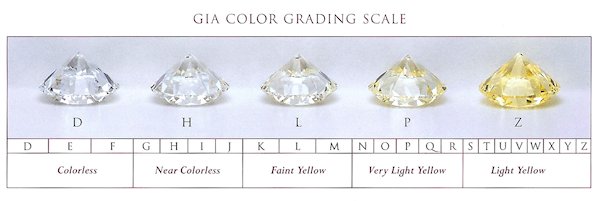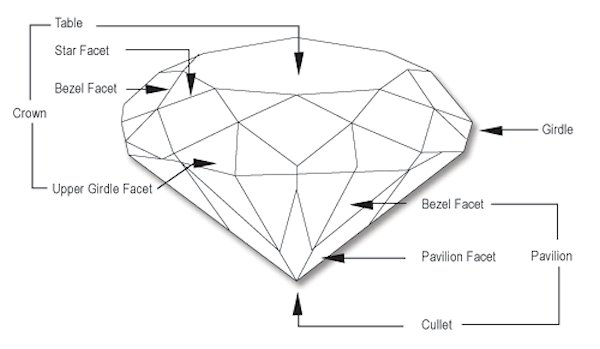Technical Information
Technical information about diamonds & purchasing them:
When buying a diamond, you need to look at the following characteristics:
- Clarity
- Cut
- Carat Weight
- Certification
- Shape
Colour:

Unlike most other gemstones Diamonds are graded on their lack of colour. As a diamond is pure Carbon it should have no colourations, perfectly see through and with no tinges of yellow. Here at Brilliant diamonds, we will only sell diamonds that are colourless to near colourless, (D to H), the reason is simple, no one wants a diamond that looks yellow when they show it to others. When you are online, you are relying on US to do the best for YOU, so we will only sell “colourless” diamonds. Diamonds get their colour from elements other than carbon in the lattice structure of the stone. A typical element found in diamond is Nitrogen, nitrogen gives the diamond a more yellow appearance. A more yellow coloured diamond, for example, an I colour, will always be cheaper than the equivalent G or F colour diamond.
When you are buying your diamond, think of what metal you will be having it in, if it’s platinum or white gold, choose a higher colour grade so the diamond doesn’t appear yellow in its setting
Clarity:

Diamond clarity is all about what is inside & on the surface of the diamond. Diamond is made from carbon under extreme heat & pressure, in the depths of the earth, this means that there is always a chance that any diamond will have an inclusion of some sort. The size, colour, number and position of these inclusions and how the affect the appearance of the diamond is how we have diamond clarity.
GIA, HRD, IGI, all use the same naming systems for the clarity of a diamond, they differ only in the classification of “eye visible” included diamonds, HRD uses the French term “pique” the GIA uses “included” giving us I & P clarity gradings.
Diamonds above 0.47ct are graded on clarity with subdivisions. All gradings are carried out under 10 times (10X) magnification.
The clarity system is as follows:
- Internally Flawless (IF)
- Very Very Small inclusions 1 (VVS1)
- Very Very Small inclusions 2 (VVS2)
- Very Small inclusions 1 (VS1)
- Very Small inclusions 2 (VS2)
- Small Inclusions 1 (SI1)
- Small Inclusions 2 (SI2)
- Included/Pique 1 (I1/P1)
- Included/Pique 2 (I2/P2)
- Included/Pique 3 (I3/P3)
Here at Brilliant diamonds, we do not stock anything LOWER than SI2, we will even pull SI2’s out of our diamond list as we want to be sure that ANY diamond bought from us has NO eye visible inclusions, we are sure that our customers want the best, and as such we strive to give only the best possible diamonds for our clients.
To the trained eye, the difference between VS2 & SI1 is obvious, but to the naked eye, there is no difference, even under magnification many people will struggle to spot the difference.
Included stones however are totally obvious to all observers and because of this we will not stock them.
Cut:

Cut is much more than the shape of a diamond, there are different thing to look for when inspecting a diamond for its “cut”.
Round brilliant cut is the most popular cut due to its excellent fire & brilliance, Princess is a very popular cut also for people who prefer square shaped stones, and Cushions, Ovals, Emeralds, Pear, Heart, Marquise & Asscher cut diamonds complete the list of commonly found diamond cuts.
In terms of “cut” grading, we are talking really about how the diamonds facets interact with light.
All diamonds graded on cut by reputable diamond grading laboratories have been measured with precise instruments and will have these details listed on the diamond grading certificate.
We will be talking firstly about the round brilliant cut diamond. The round brilliant cut diamond is the brightest diamond cut because it has the same refractive properties from almost every angle, repeated 8 times by point of observation around the stone.
What sets apart a round brilliant cut diamond that is classified as “Excellent” and one that is classified lower is generally a few basic measurements.
Almost all “Excellent” cut round brilliant cut diamonds are between 58% to 62% depth, this is the depth in relation to the diameter of the stone, any more or less generally affects the reflection of light from the pavilion (the lower part of the stone) and if we go far enough in either direction (too deep or too shallow) and have a lower than “Good” grading, we end up with a stone that is either quite dark looking, or quite flat & lifeless. Here at Brilliant diamonds, we will not stock anything lower than a “Good” cut grading, and generally we steer people to purchase diamonds in the “Very good” or better range.
Cut is the only thing that we can do to alter the value or price of a diamond, 2 diamonds exactly the same, but one cut poorly & the other excellently will have drastically different values, as such, it’s important to go for the best.
You will notice that there is no Cut grading on other shapes, that is because, unlike the round brilliant no definitive mathematical formula has ever been stipulated as “perfect”, and because of this, no laboratory grades anything but round brilliant cut diamonds on a scale from “Poor” to “Excellent”.
There are however some basic rules for fancy shapes, which most of the time are adhered to in a “guideline” fashion. For example, the optimum depth for a round diamond is 60%, but for princess cut diamonds, or other similar shaped diamonds, 70% seems to be the most common depth, this is of course much trickier when looking at an Asscher cut or Pear cut diamond. With fancy shapes you also must look more closely at the dimensions, sometimes a Princess cut isn’t quite square, with one side more than 5% bigger than the other, this means, that the diamond is cheaper to purchase because it isn’t as attractive to look at.
Carat Weight:
The easiest part of the entire diamond “4C’s” is the Carat weight. A carat is 200 milligrams, 1 gram is 5 carats. Anything under 1 carat, is described in points, there are 100 points per carat, so a 0.50ct diamond is 50 points – 0.50pts. Anything bigger than 1ct is described decimally, example: 1.20ct is 1 carat & 20 points in size. It is important to realise when purchasing your diamond, that when you buy a 0.50ct diamond it doesn’t look 50% the size of a 1.00ct diamond, a 0.50ct diamond is only around 20% smaller than a 1.00ct diamond when viewed from above.
Certification:
Sometimes called the 5th “C”, in diamond circles, certification is far more important today in a digital/online world than ever before. We only stock GIA, HRD & IGI certified diamonds on our website, the most common being GIA, the GIA is an institute based in California USA and is often described as the world leader in the gemmological field, it is also one of the most prolific diamond grading laboratory in the world. HRD is the Diamond High Council based in Antwerp, Belgium, and is renowned as the foremost continental European grading laboratory, an industry specialist due to its roots as an internal diamond industry grading laboratory. IGI is also from Antwerp, Belgium and is an ISO certified diamond grading laboratory, and is relatively new in comparison to both the HRD & GIA but they are again one of the most common certificates on the market in the “fine” jewellery market.
All grading carried out by the GIA, HRD & IGI would largely correspond, they are very similar, the differences are minor and highly technical, for example, GIA grades colour by stating that their “master stones” are the “best” of that colour, whereas HRD “master stones” are usually the “worst” of that specific colour, this means that occasionally you will have a diamond that is classed as “F” on one, yet “G” on another certificate, but it is the same colour, only their grading system is very slightly different. Other differences include the usage of “Pique” vs “Included” for diamonds with eye visible inclusions, and the classification of borderline SI2 diamonds, sometimes under strict to the rules classifications a diamond that is SI2 can have an eye visible inclusion, here at Brilliant diamonds we again try to steer people to purchase SI1 diamonds or better, as they will ALWAYS appear “eye clean”.